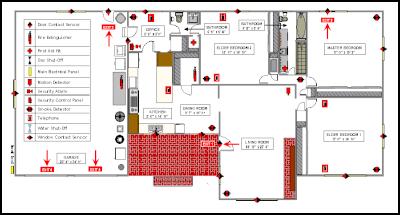‘Smart’ houses for home security and elder-care
Communication & Marketing
Massey University
Palmerston North
Friday, March 24, 2006
‘Smart’ houses for home security and elder-care

Click for big version
An example of an eldercare facility with multiple sensors
Increased life expectancy in developed countries is driving the demand for technology enabling home environments in which the elderly can live independently.
Researchers from the University’s Institute of Information Sciences and Technology are collaborating with the Institute for Infocomm Research in Singapore to design and build “smart-rooms”.
The new technology is designed to monitor the movements of people in a house, without the use of invasive video cameras, and has applications for home-security systems and the care of the elderly.
Massey’s Dr Liyanage De Silva says one of the main requirements for elder-care is the provision of an independent home-life, but with on-call health provision. Essentially, this requires automated monitoring that is sophisticated enough to accurately assess distress or acute change in the client, while remaining entirely non-invasive and unobtrusive.
He says the design of human-tracking systems without cameras is a step forward for smart-room systems monitoring the elderly in their homes as part of their care. The current system they are fine-tuning allows the remote tracking of a person’s movements in a house via multiple low-power sensors with the use of a photodiode acting as the ‘eye’ for the circuit.
The system’s audio sensors detect noises such as shouts, coughs and the sound of someone falling down. Infrared sensors or carbon dioxide sensors can be used to detect motion and magnetic sensors can be used to detect the opening and closing of doors. Illumination sensors detect changes in illumination occurring when light reflects off a person as they pass a lighted surface.
Currently under trial in a laboratory environment in the Singaporean institute, the prototype system integrates the multi-modal information from the various sensors to detect events such as falling, walking, standing and shouting. The researchers plan to extend the detectors to be both audio and light sensitive, enabling the system to trigger an alarm in a central monitoring station in cases of unusual behaviour.
ENDS


 University of Auckland: Tributes Flow For Much Loved Pacific Leader Melegalenu’u Ah Sam
University of Auckland: Tributes Flow For Much Loved Pacific Leader Melegalenu’u Ah Sam NZEI: Ministry Of Education Cuts Will Disproportionately Affect Pasifika
NZEI: Ministry Of Education Cuts Will Disproportionately Affect Pasifika Day One Hapai te Haeata: Call To Action For Young Filmmakers Against The Backdrop Of Funding Cuts
Day One Hapai te Haeata: Call To Action For Young Filmmakers Against The Backdrop Of Funding Cuts Toyota New Zealand: Three Races For Top Three To Decide TR86 Title
Toyota New Zealand: Three Races For Top Three To Decide TR86 Title Wellington City Council: Wellington Is All Action Stations For The Faultline Ultra Festival
Wellington City Council: Wellington Is All Action Stations For The Faultline Ultra Festival Melanie Allison: Local Playwright Casts A Spell Over Hamilton
Melanie Allison: Local Playwright Casts A Spell Over Hamilton